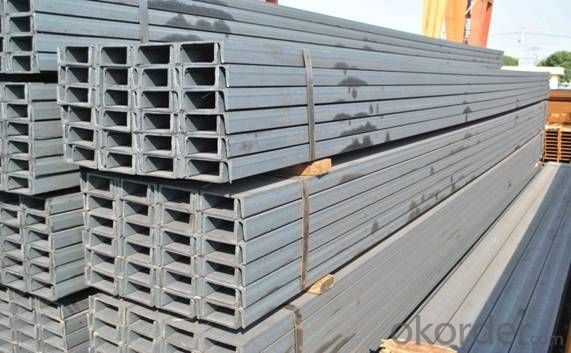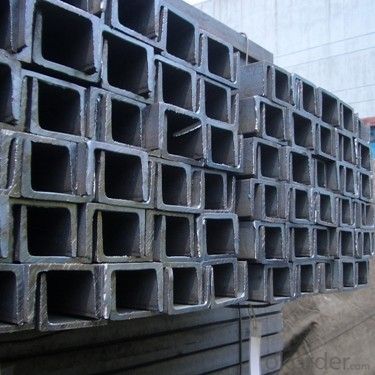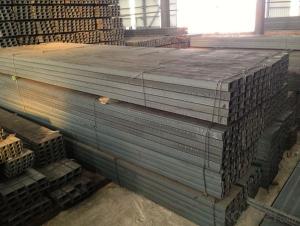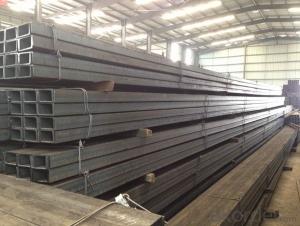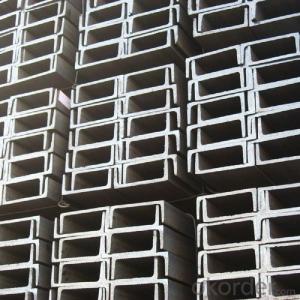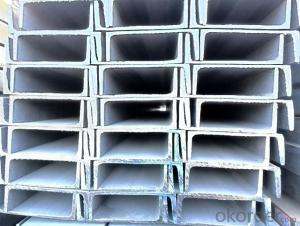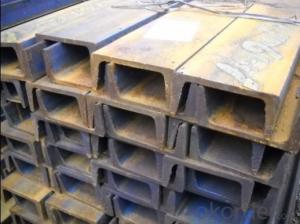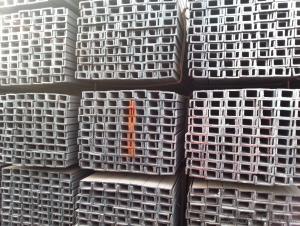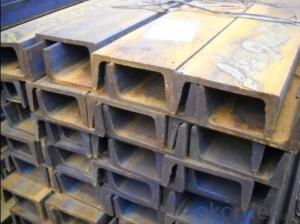50mm JIS Standard U Channels for construction
- Loading Port:
- Tianjin
- Payment Terms:
- TT OR LC
- Min Order Qty:
- 25 m.t.
- Supply Capability:
- 10000 m.t./month
OKorder Service Pledge
OKorder Financial Service
You Might Also Like
Product Applications:
Japanese Standard U-channels are ideal for structural applications and are widely used in the construction of buildings and bridges, and the manufacturing, petrochemical, and transportation industries.
Product Advantages:
OKorder's Japanese Standard U-channels are durable, strong, and resist corrosion.
Main Product Features:
· Premium quality
· Prompt delivery & seaworthy packing (30 days after receiving deposit)
· Corrosion resistance
· Can be recycled and reused
· Mill test certification
· Professional Service
· Competitive pricing
Product Specifications:
Manufacture: Hot rolled
Grade: Q195 – 235
Certificates: ISO, SGS, BV, CIQ
Length: 6m – 12m, as per customer request
Packaging: Export packing, nude packing, bundled
Product Applications:
Japanese Standard U-channels are ideal for structural applications and are widely used in the construction of buildings and bridges, and the manufacturing, petrochemical, and transportation industries.
Product Advantages:
OKorder's Japanese Standard U-channels are durable, strong, and resist corrosion.
Main Product Features:
· Premium quality
· Prompt delivery & seaworthy packing (30 days after receiving deposit)
· Corrosion resistance
· Can be recycled and reused
· Mill test certification
· Professional Service
· Competitive pricing
Product Specifications:
Manufacture: Hot rolled
Grade: Q195 – 235
Certificates: ISO, SGS, BV, CIQ
Length: 6m – 12m, as per customer request
Packaging: Export packing, nude packing, bundled
Quick Details
Place of Origin:Hebei, China (Mainland)
Material:Steel
technique:hot rolled
Standard:AISI,ASTM,BS,DIN,GB,JIS
thickness:3-9mm, 6-13mm
Application:Building construction
Width:50mm-300mm
Length:6m-12m or as your request
Shape:U shape
Material:Q235, SS400 etc
Normal Length:12m/6m
Packaging & Delivery
| Packaging Details: | according to the customer's request |
|---|---|
| Delivery Detail: | about 25-30 days after receive your payment |
Specifications
channel steel
1)Size: 51x25x3mm-305x80x13mm
2)Material: Q195,Q215,Q235,A36,SS400,SS540
3)Packing:bundle with strips
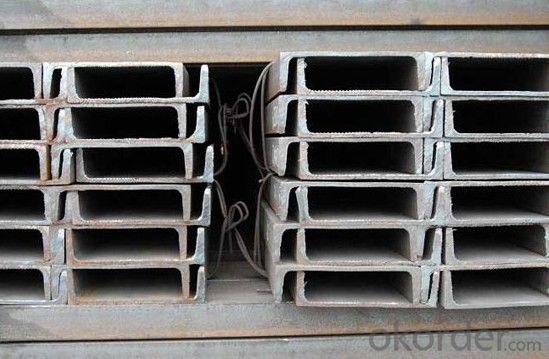
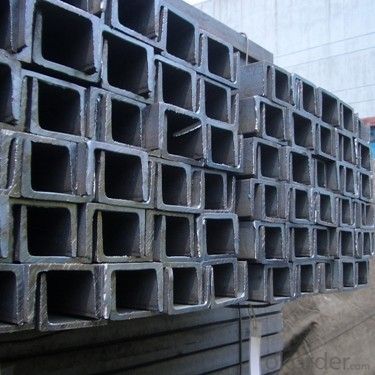
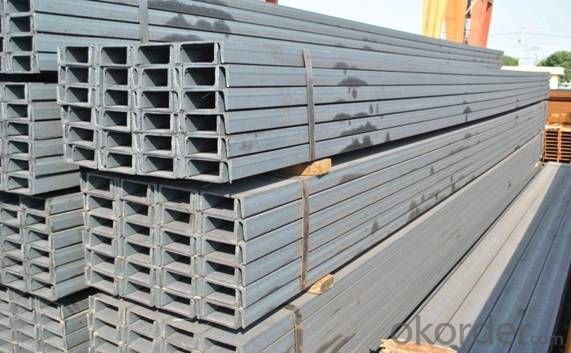
- Q: What are the different surface finishes available for steel channels in architectural applications?
- Some of the common surface finishes available for steel channels in architectural applications include mill finish, galvanized finish, powder-coated finish, and brushed finish.
- Q: How do steel channels contribute to sustainable construction practices?
- Steel channels contribute to sustainable construction practices in several ways. Firstly, steel is a highly durable and long-lasting material, which means that structures made with steel channels have a longer lifespan, reducing the need for frequent repairs or replacements. Additionally, steel channels are often made from recycled steel, which helps to conserve natural resources and reduce the environmental impact of mining and processing new materials. Moreover, steel is a highly recyclable material, meaning that at the end of a structure's life, the steel channels can be easily recycled and used in new construction projects, reducing waste and promoting a circular economy. Lastly, steel channels provide strength and stability to structures, allowing for efficient designs that require fewer materials, resulting in reduced energy consumption during construction and lower carbon emissions. Overall, the use of steel channels in construction helps to achieve sustainability goals by promoting durability, resource conservation, waste reduction, and energy efficiency.
- Q: What are the factors to consider when determining the appropriate thickness of a steel channel?
- When considering the appropriate thickness of a steel channel, there are several factors that need to be taken into account. These factors include the load that the steel channel will bear, the length of the channel, the properties of the steel being used, and any relevant building codes or regulations. The load is the most crucial factor to consider. The steel channel must be able to support the weight or force placed upon it without bending or collapsing. The type and magnitude of the load, whether it is static or dynamic, and any potential impact or live loads should all be considered. Calculations or engineering analysis may be necessary to determine the appropriate thickness based on the expected load. The length of the steel channel is another important consideration. Longer spans require thicker steel channels to prevent deflection or sagging. The longer the span, the more potential there is for flexing, so a thicker channel will provide the necessary rigidity and support. The properties of the steel being used also play a role in determining the appropriate thickness. Different grades of steel have different strength and stiffness characteristics, which should be taken into account when selecting the thickness. Material properties such as yield strength, tensile strength, and modulus of elasticity should be considered. Furthermore, any relevant building codes or regulations should be considered. Local building codes often specify minimum thickness requirements for structural elements, including steel channels. These codes are in place to ensure the safety and integrity of the structure, so it is essential to comply with them. In conclusion, careful consideration should be given to factors such as the load, span, material properties, and building codes when determining the appropriate thickness of a steel channel. A comprehensive analysis should be conducted to ensure that the chosen thickness will provide adequate strength and support for the intended application.
- Q: Can steel channels be used for supporting signage and billboards?
- Yes, steel channels can be used for supporting signage and billboards. Steel channels are known for their strength and durability, making them suitable for providing structural support to hold and secure various types of signage and billboards.
- Q: Can steel channels be used in the aerospace manufacturing industry?
- Yes, steel channels can be used in the aerospace manufacturing industry. Steel channels are versatile and strong structural components that can be used in various applications within the aerospace manufacturing industry. They can be employed in the construction of aircraft frames, wings, and other structural components. Steel channels offer excellent strength-to-weight ratio, making them suitable for aerospace applications where weight reduction is crucial. They can withstand high temperatures, extreme loads, and harsh operating conditions, making them ideal for use in the aerospace industry. Furthermore, steel channels can be easily fabricated, welded, and assembled, allowing for efficient and cost-effective manufacturing processes. Their dimensional stability and durability ensure the longevity and reliability of aerospace components. However, it is important to note that the selection of materials in the aerospace industry is a critical process, and specific requirements and regulations must be met. Therefore, engineers and designers must carefully evaluate the application, performance, and compliance of steel channels before incorporating them into aerospace manufacturing processes.
- Q: Can steel channels be used for catwalks?
- Yes, steel channels can be used for catwalks. Steel channels are commonly used in construction for their strength and durability. They provide a stable and secure platform for individuals to walk on, making them suitable for catwalks. Additionally, steel channels can be easily customized and fabricated to meet specific design requirements, such as length, width, and load-bearing capacity, making them versatile for various catwalk applications.
- Q: What are the different fabrication techniques used for steel channels?
- There are several different fabrication techniques used for steel channels. These include hot rolling, cold rolling, and extrusion. Hot rolling involves heating the steel billet and passing it through a series of rollers to shape it into the desired channel profile. Cold rolling, on the other hand, is performed at room temperature and involves passing the steel through rollers to achieve the desired channel shape. Extrusion is another technique where the steel is forced through a die to create the channel profile. Each of these techniques has its own advantages and is chosen based on factors such as the required dimensions, strength, and cost considerations.
- Q: What are the typical applications of steel channels?
- Steel channels have various typical applications across multiple industries. They are commonly used in construction projects for framing, supporting structural loads, and creating framework for buildings, bridges, and infrastructure. Steel channels also find applications in manufacturing, where they are utilized as structural components in machinery, equipment, and vehicles. Additionally, they are frequently employed in the production of storage racks, shelving systems, and electrical enclosures. Overall, steel channels are versatile and widely used due to their strength, durability, and ability to provide structural support in a variety of applications.
- Q: What are the different types of connections used for steel channels in steel bridges?
- Steel bridges commonly use several different types of connections to join steel channels. These connections play a crucial role in maintaining the bridge's structural integrity and stability. One frequently used connection type for steel channels is the bolted connection. This method involves connecting steel channels using bolts and nuts. The bolted connection offers flexibility and ease of assembly and disassembly, making it a popular choice in bridge construction. Another connection type is the welded connection, where steel channels are joined by welding. This creates a strong and permanent connection, often used in areas requiring high load transfer and rigidity. While riveted connections were once common in older steel bridges, they are less prevalent in modern bridge construction. Riveted connections involve joining steel channels using rivets, metal pins hammered or pressed through holes in the channels. Riveted connections offer good load transfer and durability but are more time-consuming and labor-intensive compared to bolted or welded connections. In addition to these common connection types, proprietary connection systems are available in the market. These systems, designed and manufactured by specific companies, offer unique advantages such as improved performance, increased construction speed, or cost savings. They may utilize mechanical fasteners, adhesives, or hybrid connections to join steel channels in steel bridges. Ultimately, the choice of connection type depends on various factors, including design requirements, loadings, fabrication capabilities, cost considerations, and durability requirements. Bridge engineers and designers must carefully assess these factors to select the most appropriate connection type, ensuring the safety and longevity of steel bridges.
- Q: Can steel channels be used for stair stringers in commercial buildings?
- Stair stringers in commercial buildings can indeed utilize steel channels. The strength and durability of steel channels make them a popular choice in construction. By offering remarkable support and stability to staircases, they prove to be ideal for commercial buildings that anticipate heavy foot traffic. Moreover, steel channels can be tailored to meet specific design needs, granting flexibility in constructing stair stringers.
Send your message to us
50mm JIS Standard U Channels for construction
- Loading Port:
- Tianjin
- Payment Terms:
- TT OR LC
- Min Order Qty:
- 25 m.t.
- Supply Capability:
- 10000 m.t./month
OKorder Service Pledge
OKorder Financial Service
Similar products
Hot products
Hot Searches
Related keywords





